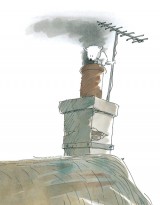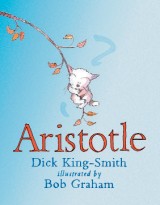While children are under the spell of Aristotle, the story of a witch's kitten, there will be many opportunities to improve their writing...
Aristotle is a bold and curious kitten who cannot help getting into trouble. Luckily, his owner Bella Donna is always on hand to rescue him with a little magic. The book is written as a series of adventures as Aristotle works his way though some of his nine lives. It works brilliantly as a mentor text, engaging children through its use of humour and descriptive language, and introducing them to stories with chapters.
 Turn the role play area into Bella Donna’s cottage, using the illustrations in the book for inspiration.
Turn the role play area into Bella Donna’s cottage, using the illustrations in the book for inspiration.
In role as Bella Donna, welcome the children into your cottage and, without revealing the illustrations, read the opening episode of the story where Aristotle loses the first of his lives.
Explore children’s response to the story using Aidan Chambers’ booktalk prompts of likes, dislikes, puzzles and patterns.
Ask some literal questions about what you have read: What does Bella Donna look like? How did Aristotle fall down the chimney?
Then move into questions that will prompt deductive and inferential responses: what kind of person do you think Bella Donna is? What kind of kitten do you think Aristotle is? If necessary, model the type of response that you expect.
Come out of role and explain to the children that they are going to learn how to tell the first part of Aristotle’s story. Create a story map of key events and teach children the story, referring to the story map and using gestures to reinforce specific words and phrases. A suitable version for oral storytelling is supplied here:
Once upon a time there was
a little white cat called
aristotle who lived with a
little old lady called
Bella Donna.
Early one sunny morning
Aristotle woke up and Bella
Donna said, “Now just you
be careful!”
Do you think Aristotle listened to
Bella Donna? No, he did not!
First, he explored upstairs… but
there was only an old bed.
Next, he explored the cellar…
but there was only an old
cooking pot.
After that, he explored the
kitchen… but there was only a
pile of washing up!
Finally, he went outside.
Aristotle thought that he’d like to
get onto the roof.
So, he climbed and he climbed
and he climbed up the creeper.
He crept and he crept and he
crept along the thatch.
Then, because he was curious as
all cats are, he scrambled up the
chimney stack and looked down
the chimney pot.
At that very moment, a puff of
smoke came up, right in
Aristotle’s face and down the
chimney he fell.
He fell and he fell and he fell till he
landed right in front of Bella
Donna. Unfortunately, he was no
longer a white cat – he was
covered in soot.
“Well my boy, that’s the first of
your nine lives gone. You’d best
be more careful!”
Rehearse with the children until they are confident in retelling the story. Meanwhile, read the rest of the book, episode by episode. Make comparisons between events, establish when Bella Donna is using magic to save Aristotle and encourage empathy with the characters.
 Establish an authentic audience and purpose for the forthcoming writing activity by organising the arrival of a letter from Bella Donna. In her letter, she tells the children that she now has another kitten, called Hemlock. He is just as mischievous as Aristotle. So far, he has hidden in a sack and been mistaken for post by the postman; followed a mother duck and her ducklings to the farmyard and fallen into the pond; and, just yesterday, he tried to find out what was in a box and managed to tip it over on top of himself. Bella Donna would really like the children to write a book about her new kitten’s adventures so that he doesn’t feel left out.
Establish an authentic audience and purpose for the forthcoming writing activity by organising the arrival of a letter from Bella Donna. In her letter, she tells the children that she now has another kitten, called Hemlock. He is just as mischievous as Aristotle. So far, he has hidden in a sack and been mistaken for post by the postman; followed a mother duck and her ducklings to the farmyard and fallen into the pond; and, just yesterday, he tried to find out what was in a box and managed to tip it over on top of himself. Bella Donna would really like the children to write a book about her new kitten’s adventures so that he doesn’t feel left out.
Explain that, as a class, you are going to write one of Hemlock’s adventures together and then the hildren will try writing one on their own.
Return to the oral version of the first episode and box it up to establish the underlying structure.
• Main character is curious and decides to explore
• He carries out the exploration
• He gets into trouble
• His owner rescues him
• Main character receives a warning from his owner
Demonstrate how to use the boxed up version to plan and develop a story about one of Hemlock’s adventures.
During shared writing, borrow some of Dick King Smith’s words, phrases and techniques and use them in the story.
Support the children, as they emulate what you have modelled, in planning and writing their own stories.
Feedback on the children’s stories could come from Bella Donna herself in the form of another letter. Or, she may even have visited the classroom overnight, scattered gold stars on the floor and marked children’s books using a magical gold pen!
 By now, children will be very familiar with the story of Aristotle and they will enjoy opportunities to spring off the page into a wide range of cross-curricular activities.
By now, children will be very familiar with the story of Aristotle and they will enjoy opportunities to spring off the page into a wide range of cross-curricular activities.
They could write Bella Donna’s Book of Spells, compose songs for a musical version, develop a map of the area around the cottage, identify places where Aristotle got into trouble, give directions for getting from one place to another or design and make toys to keep young kittens out of mischief.
Having explored the book in this way, children have responded to, and reflected on, the story, the characters and the author’s techniques at a level appropriate to their age and ability. They have created their own version of an adventure story and used the book as the context for various crosscurricular activities.
Aristotle may have also served to introduce Dick King Smith as an author. Children could move on to read other books such as Hodgeheg, The Sheep Pig or the Sophie series. Or, you may wish to turn to other short novels that can act as KS1 mentor texts, such as The Man Who Wore all his Clothes by Allan Ahlberg, or the perennial favourite Roald Dahl’s The Enormous Crocodile, to further reinforce the notion that good readers make good writers.
 • Aristotle (Walker Books) by Dick King Smith.
• Aristotle (Walker Books) by Dick King Smith.
• Tell Me: Children, Reading and Talk (Thimble Press) by Aidan Chambers.
• Find contact details and more information about Good Readers Make Good Writers at theplc.org.uk
Gill Matthews is an independent literacy consultant and writer. She works with and in schools, supporting improvements in literacy. She delivers INSET and speaks on many aspects of literacy both nationally and internationally.
Last issue, Gill Matthews explored the principles and practice underpinning the Good Readers Make Good Writers course developed by the Professional Literacy Company. This concentrates on using mentor texts to create not only interested and reflective readers but also resourceful and committed writers. You can find last issue’s article in the resources section on the Teach Primary website (teachprimary.com). Here, she focuses on KS1 using Aristotle by Dick King Smith.
Use scaffolding to wean children off high levels of TA support
Ace-Kitchen-Manager
Help Pupils Tell Fact From Fiction In The Digital World
Ace-Computing
